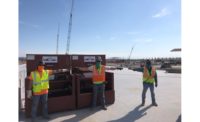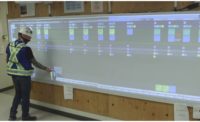
Go to any property and construction technology panel and someone is inevitably going to say that the construction industry has been slower than other sectors to adopt tech-forward practices, but this ignores how responsive construction has been to solving problems for as long as people have been building.
The misperception is due to a major difference between construction and design and other sectors: the products construction companies deliver are built to be used heavily by many people for decades and even centuries and they need to be absolutely sure that a technology will add value, because mistakes are magnified in an industry where the clients and the public are using the products for the very long term, and corrections are difficult and costly to make.
The reality isn’t that construction and design professionals are resistant to change; it’s that they need to be sure that what they are changing really improves on the tried and true. This means that conTech startups and ventures need to clear a high bar and demonstrate tested, added value, and the process can be arduous, but also highly valuable for owners and the public. COVID-19, However, has put an urgency on a number of issues and the industry needs to think more systematically about what technologies it pursues in order to accelerate efficiencies in a tighter market.
Acceleration During the Pandemic
The COVID-19 pandemic was an unprecedented shock to the global built environment in everything from project funding and public safety to supply chains and personnel management. However, as the economy started its recovery, construction was one of the first industries to get back to essential work, and construction companies have needed to adapt quickly to newer ways of working. What building professionals are finding though is that the pandemic didn’t exactly bring new challenges as much as it accelerated changes that were already underway, bringing the needs for sustainability, efficiency, cost management and safety sharply into focus —issues that conTech innovators have been working to solve for some time.

COVID-19 created the need for social distancing on site and in the office, but the industry was already embracing more industrialized and digital processes to reduce manual and in-person tasks, increasing cost efficiency and safety. Advances in BIM, virtual reality and drones allow engineering, design and inspection decisions to be made in digital environments that reduce costly mistakes and reduce the health and safety dangers inherent in having more people on-site and in high-risk situations. Digital twins are increasingly being adopted to monitor aspects of building performance that significantly reduce the need for manual monitoring and risk management, while various project management software solutions are making teams and processes more agile, effective and data-driven while reducing the friction of remote work and widely dispersed personnel.
The economic pressures of the pandemic-related slowdown have made cost efficiency and sustainability crucial aspects of building and design strategy. Lenders are imposing more stringent underwriting requirements and tighter budgets mean a need for fewer change orders. Projects require an unprecedented level of planning, coordination and cost management in advance of physical benchmarks, and digital and remote technologies help achieve that safely and with continually deeper levels of insight.
The best startup technologies are problem-based; they were developed to address a specific industry need. In the construction industry, most startups are created by knowledgeable industry professionals who have a passion for what they’re developing. You also find outsiders who identified a problem related to construction and invested in fixing that issue, but it’s important to ensure they have the right people to make it work for how these professionals do their jobs.
How to Strategize for Building Innovation
So the question then becomes how do design firms and construction companies evaluate new design and construction technologies and strategize how to invest their resources in a tighter market? For this, the 70-20-10 model is a reasonable way to think about how your firm looks at innovation. A company could devote 70% of its innovation efforts to sustaining and expanding the applicability of the new technologies and processes that it already uses and knows work. It could allocate 20% to exploring adjacent markets that may have applicability to the construction and design industries. Finally, it could devote 10% of that effort to fostering disruptions either in-house or by supporting startups with promise and applicability to your business.
If your company is having success with VR and BIM, then keep using them and expand their efficiencies wherever possible on your projects. There is limited risk in doing this because as an industry we know it works for the vast majority of building firms. Invest in training and hiring more personnel who are proficient in it so it becomes standard practice. The added bonus of this is that by adopting technology more widely, you’re better able to attract and retain young talent, which increasingly is looking for forward-thinking firms.
Another example is at Syska, where we rolled out an enterprise resource planning (ERP) system that integrates all of the company’s operational functions, such as HR, payroll, finance, project management, sales, business development and customer relationship management. By investing effort, time and resources to applying the technology as widely as possible and optimizing the capabilities of each function’s software, we created as many efficiencies as possible with what we knew worked. Similarly, Anchin’s own Digital Risk System looks at past performance compared to today to identify the projects that have the best margins and analyze what patterns and anomalies stand out that drove those results, from personnel to budget. These systems for both firms are proven to work and are driven by best practices in benchmarking, operations and cost analysis. All of this also requires a robust internal culture that prioritizes regular assessment to determine if the processes and technology in place can deliver the data needed. If not, it may become useful to look outside the firm or even the industry.
To explore adjacent markets, it’s useful to set up a working group, a practice or even a new company within your parent organization to find and support startups with groundbreaking ideas. Your innovation group can join networks that invest in seed-stage companies serving the building community specifically, reducing risk in your investments. These networks also grant access to research reports and analysis on the latest advances in smart buildings, drones, renewable energy and more.
When looking to drive disruption and innovation through your own organization, it’s still useful to work with incubators, but you should leverage your organization’s own expertise. Unlike the startups, you probably have more experience in working closely with industry leaders like owners or architects, so you can bring key insights for them and help to develop their go-to-market strategies that make their products attractive to potential end-users.
It is important, however, to remember that any innovations you develop address industry-wide challenges and not just internal issues. Keep a wide perspective to think about applicability. Also think about using technologies that exist to refine them for the construction industry. Augmented reality (AR), for instance, is still in its infancy, but it is increasingly likely that it is going to play a key role in the future of the industry. The ability to use goggles that present digital overlays on an existing space can identify risks and new design and engineering possibilities. Finding startups now that utilize this technology is increasingly a solid investment.
It’s important to remember that necessity is driving rapid change, and while you and your firm should look to adopt new technologies, it’s also crucial to be smart and methodical about the way you do that. Design and construction professionals are ultimately responsible for making smart decisions based on trusted methods, and driving change should be no different.
Phillip Ross is an accounting and audit partner at Anchin, Block & Anchin LLP and serves as the leader of the firm’s Architecture and Engineering and Construction Industry groups. As co-president of Syska Hennessy Group, Cyrus Izzo leads one of the world's leading engineering firms, with more than 500 professionals across 16 offices.





Post a comment to this article
Report Abusive Comment